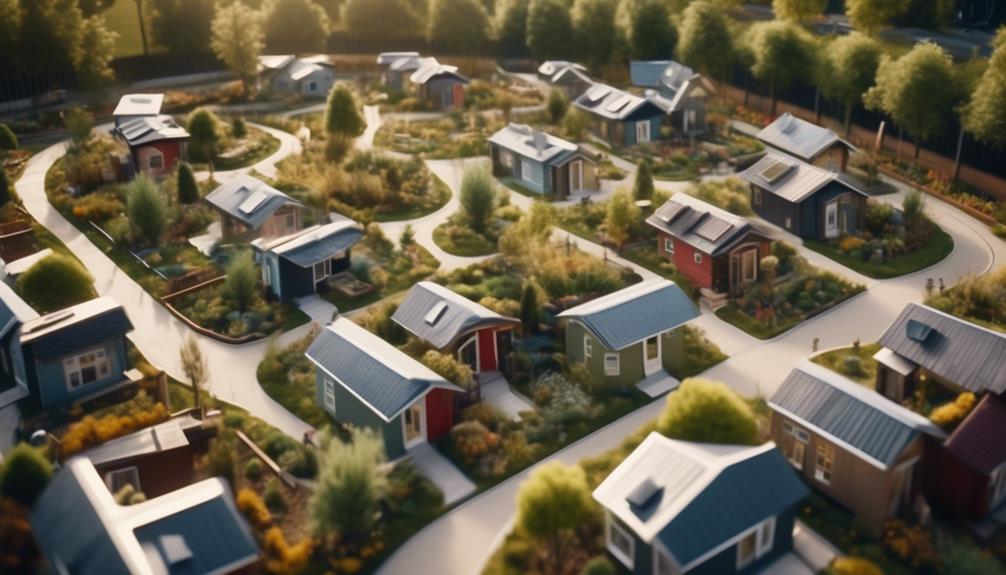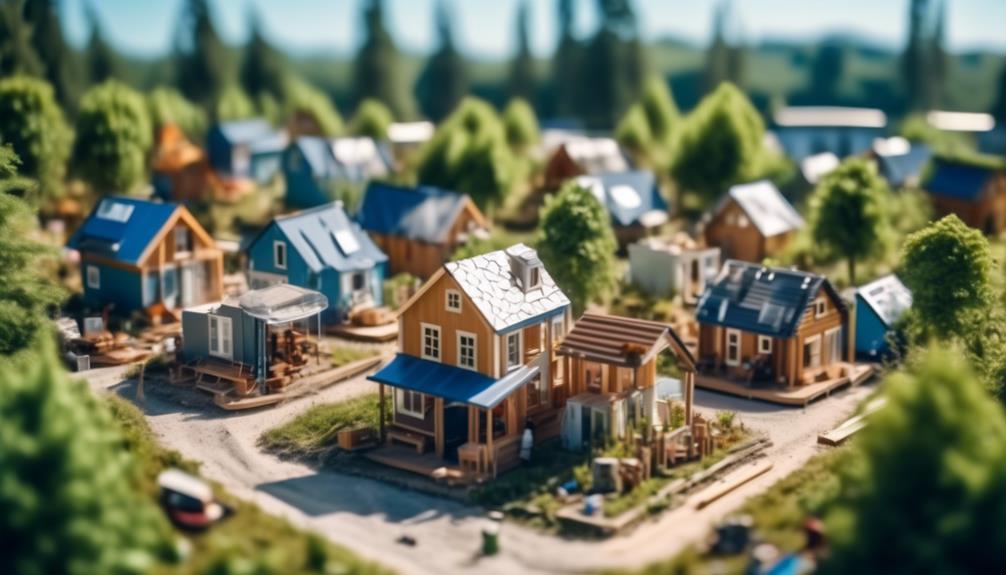Nearly 68% of tiny house owners have no mortgage, a statistic that might have caught your eye as you consider the financial freedom and minimalist lifestyle that a tiny home community could offer you.
As you're contemplating this shift, you'll find that there's more to it than just downsizing your living space. You're looking at a chance to forge authentic connections and revel in a close-knit community that's in harmony with both its inhabitants and the environment.
However, establishing such a community comes with its unique set of challenges and considerations, from navigating zoning laws to designing communal spaces that foster togetherness.
As you weigh the possibilities, you'll need to understand the intricate details that can make or break your vision of an idyllic tiny home community.
Stay with us as we explore the essentials that can help you turn this burgeoning lifestyle choice into a sustainable reality.
Key Takeaways
- Understanding local zoning laws and regulations is crucial for starting a tiny home community.
- Prioritize land acquisition in areas with friendly zoning regulations and existing infrastructure.
- Efficient space utilization and sustainable infrastructure are important considerations in designing the community layout.
- Strategic fundraising and engagement with people interested in affordable housing solutions are necessary for securing funding and permits.
Understanding Zoning Laws
To effectively launch a tiny home community, you must navigate the intricate web of local zoning laws that regulate land use, home size, and placement.
You'll find that zoning regulations, a fundamental facet of local planning, are the linchpin in determining the feasibility of your real estate venture. Cities and counties possess distinct zoning codes, which you must scrutinize to align your project with the local planning and zoning framework.
Engage proactively with the planning department to elucidate the nuances of Zoning Laws and building codes that apply to your tiny home community. Each zone carries its own permissions, potentially accommodating tiny homes as RV parks or accessory dwelling units (ADUs).
Strategic collaboration with local officials is paramount in navigating and addressing zoning concerns for a successful tiny home community launch.
Choosing the Ideal Location
When selecting the perfect site for your tiny home community, it's crucial to weigh the proximity to essential amenities and services, ensuring the location meets both the practical needs of residents and complies with local zoning regulations.
Strategically target land acquisition where zoning is friendly to tiny houses on wheels or resembles an RV park framework. Prioritize suitable land with existing infrastructure to minimize costs on building materials and ensure a reliable water supply.
Innovative thinking is paramount—consider places to park that offer a blend of accessibility and natural charm, enhancing the community's allure. Engage analytically with local stakeholders, mapping out regulatory pathways to fortify the community's foundation.
Your strategic land choice sets the stage for a thriving, compliant, and innovative tiny home enclave.
Designing the Community Layout

Carefully designing the layout of your tiny home community not only maximizes the use of available space but also cultivates an environment where social interaction and individual privacy strike a harmonious balance. To ensure you're on track, consider the following:
- Efficient Space Utilization: Arrange tiny homes and shared resources to allow for both community engagement and personal retreats. Think strategically about the placement of walkways and green spaces.
- Sustainable Infrastructure: Prioritize access to utilities, implementing eco-friendly solutions that align with safety standards, to support the daily needs of tiny homeowners.
- Community Focal Points: Include a community center and areas for communal activities to foster interaction within the tiny house village while respecting individual preferences.
Securing Funding and Permits
Understanding local zoning laws and building codes is critical as you secure funding and permits for your tiny home community project. In the process of starting a tiny house community, you'll need to raise funds strategically. Explore various financial avenues—consider whether to purchase land outright or obtain loans. Lease agreements may also play a role.
Securing funding and permits is a regulatory minefield; enlisting professionals knowledgeable in local laws will streamline this process. Your tiny house community takes shape only when every step, from land acquisition to ensuring your plans are likely to be legal, is meticulously planned.
Engage with people who are interested in affordable housing solutions, as they might provide both fiscal support and advocacy, which can be crucial in navigating the complexities of building tiny homes.
Building the Tiny Homes

As you embark on the construction phase, it's essential to meticulously plan the design of each tiny home to ensure that space is used efficiently and in compliance with stringent building codes. To build a community that exemplifies the principles of tiny house living, consider the following strategic elements:
- Maximize Space Utilization: Design your first tiny house with innovative storage solutions and multi-functional furniture to make the most of every square foot.
- Sustainability and Efficiency: Utilize sustainable materials and prioritize energy-efficient systems to establish your tiny home neighborhood as a beacon of eco-consciousness.
- Compliance and Innovation: Ensure each dwelling unit adheres to local ADUs regulations, while also integrating cutting-edge technologies to enhance the living experience within your permanent tiny home communities.
Attracting Community Members
Having meticulously planned and constructed your tiny homes with efficiency and sustainability in mind, it's crucial to now focus on attracting members who value community and an eco-conscious lifestyle. To start a tiny house community that's successful, your strategy should highlight the key benefits of tiny living. Create compelling narratives around the financial freedom and authentic connections tiny house villages offer to find people who are eager to live in a tiny home and invest in the lifestyle.
| Benefits of Tiny House Living | Attracting Community Members |
|---|---|
| Financial Freedom | Showcase cost-saving potential |
| Intimate Camaraderie | Promote social engagement opportunities |
| Eco-Friendly Environment | Emphasize sustainable living practices |
Craft your marketing with precision, aiming to resonate with those who are not just looking for a home, but a transformative way of life.
Frequently Asked Questions
How to Build a Community in a Tiny House?
To build a community in a tiny house, focus on neighborhood design that encourages social events and shared spaces. Promote sustainable living through garden collaboration and resource sharing, and hold workshops for collective decision-making and conflict resolution.
What State Has the Most Tiny Home Communities?
California leads the charge in tiny home communities, with its progressive zoning challenges navigated, innovative community design, and commitment to sustainable practices setting the standard in infrastructure planning and community governance.
Is a Tiny Home Business Profitable?
Yes, a tiny home business can be profitable. Market demand and sustainable living trends boost profit margins. However, zoning challenges require strategic planning, and you'll need to conduct cost analysis and explore financing options carefully.
Where Are the Best Tiny Home Communities?
The best tiny home communities balance zoning challenges with innovative community design, offering sustainable living and minimalist lifestyle perks. They navigate social dynamics, legal considerations, and land acquisition strategically, with smart financing and infrastructure planning.
Conclusion
As you step into the tiny home territory, tackle the zoning zephyrs with strategic savvy. Secure your site, sketch your settlement, and solidify support with sound funding and permissions.
Build your bijou abodes, blending beauty with brevity, and beckon the bond of community. Navigate the nuances of neighborhood niceties and norms.
Your tiny home haven, hinged on harmony and regulation rigor, isn't just a dwelling—it's a dynamic domain destined for distinction and sustainable success.

